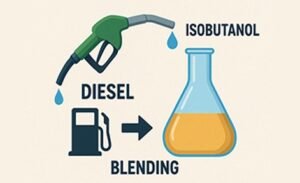
Why in News
-
Union Minister Nitin Gadkari announced trials for isobutanol–diesel blending.
-
This comes after ethanol–diesel blending trials failed.
-
ARAI is testing a 10% isobutanol–diesel blend.
Background on Ethanol Blending
-
Ethanol blending is a major biofuel policy in India.
-
Success: 20% blending in petrol achieved ahead of schedule.
-
Failure in diesel blending due to:
-
Corrosive nature of ethanol
-
Engine compatibility issues
-
-
Positive farmer impact:
-
Farmers earned ₹42,000 crore+
-
Corn prices rose from ₹1,200 → ₹2,600–2,800 per quintal
-
Exploring Isobutanol as an Alternative
-
Isobutanol: industrial alcohol, usually in paints & coatings.
-
Current trials: 10% blend with diesel.
-
Advantages over ethanol:
-
Better engine compatibility
-
Less corrosive
-
Can be used with CNG in tractors & agri-machinery
-
-
Supports:
-
Import substitution
-
Energy security
-
Farmer incomes through alternative feedstocks
-
Policy Push for Farmers and Sugar Industry
-
Government cleared 96% of cane payments; dues at record lows.
-
Push for ethanol producers:
-
Boost domestic and export output
-
Adopt 2G & 3G ethanol (bamboo, agri residues)
-
Expand distilleries
-
Industry Concerns (ISMA)
-
Demands raised:
-
Revise FRP of sugarcane in line with rising costs
-
Revise MSP of sugar (unchanged since 2019)
-
Raise sugar export quota by 2 MT for 2025–26
-
Growth in Sugar & Ethanol
-
Sugarcane production ↑ 40% in last decade
-
Sugar output ↑ 58%
-
2025 estimate: 34.9 MT sugar production (+20% YoY)
-
Stronger integration needed between sugar sector & energy policy
Challenges
-
Feedstock availability: Competing demand for sugarcane and corn may affect food security.
-
Technology readiness: Isobutanol blending still at trial stage; large-scale adoption uncertain.
-
Cost competitiveness: Production cost of isobutanol higher than fossil fuels.
-
Infrastructure gaps: Lack of blending and distribution systems across India.
-
Environmental concerns: Large-scale biofuel crop production may lead to water stress and land-use conflicts.
-
Policy uncertainty: Frequent changes in sugar, ethanol, and fuel pricing discourage investment.
Way Forward
-
R&D push: Accelerate trials and invest in domestic technology for isobutanol production.
-
Diversified feedstocks: Encourage use of bamboo, crop residues, algae to reduce dependence on food crops.
-
Stable policies: Long-term clarity in FRP, MSP, blending mandates, and export policies.
-
Infrastructure creation: Expand blending facilities, storage, and supply chain networks.
-
Farmer-centric incentives: Ensure fair pricing, timely payments, and promote crop diversification.
-
Environmental safeguards: Adopt water-efficient crops and sustainable farming practices.
-
Public–private partnerships: Attract private investment in biofuel innovation and production capacity.
Key Terms Explained
Isobutanol
-
A type of alcohol (like ethanol, but with different chemical properties).
-
Less corrosive and more stable than ethanol.
-
Can be mixed with diesel without damaging engines.
-
Also used in paints, coatings, and solvents.
Blending
-
Mixing biofuels (like ethanol or isobutanol) with fossil fuels (petrol/diesel).
-
Done to reduce pollution, lower import bills, and support renewable energy goals.
Ethanol Blending
-
Policy where ethanol (from sugarcane, corn, etc.) is mixed with petrol or diesel.
-
Common target: 20% ethanol in petrol (achieved ahead of schedule).
-
Diesel blending failed due to engine damage.
ARAI (Automotive Research Association of India)
-
Government research institute under the Ministry of Heavy Industries.
-
Tests vehicles, fuels, and emission standards.
-
Currently running trials for 10% isobutanol–diesel blending.
Fair and Remunerative Price (FRP)
-
Minimum price sugar mills must pay farmers for sugarcane, fixed by the government.
-
Ensures farmers get a fair return, even if market prices fluctuate.
Minimum Support Price (MSP)
-
Price at which government buys crops from farmers, regardless of market conditions.
-
For sugar, MSP ensures mills sell sugar at a price covering their costs.
Cane Dues
-
Pending payments sugar mills owe to farmers for supplied sugarcane.
-
Clearing cane dues quickly is important for farmer incomes and rural stability.
2G & 3G Ethanol (Second and Third Generation Ethanol)
-
2G Ethanol: Made from crop residues, bamboo, or non-food biomass (avoids food vs fuel issue).
-
3G Ethanol: Made from algae or advanced biotech processes.
-
Both are more sustainable than 1G ethanol (from food crops like sugarcane or corn).
Export Quota (for sugar)
-
Government fixes how much sugar can be exported in a season.
-
Increasing quota lets mills sell more abroad, earn better prices, and clear farmer dues.
Biofuel Policy
-
India’s roadmap to promote blending of biofuels with petrol/diesel.
-
Aims to cut crude oil imports, reduce pollution, and support farmers.




